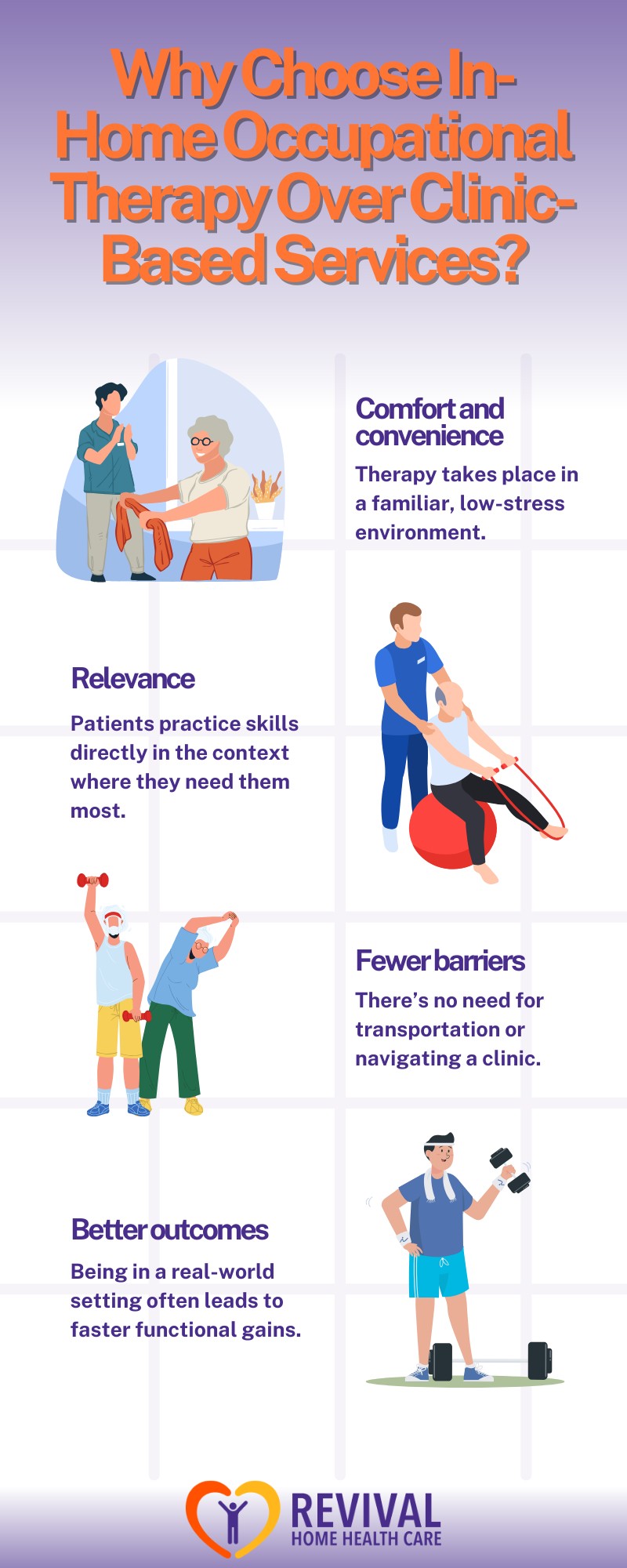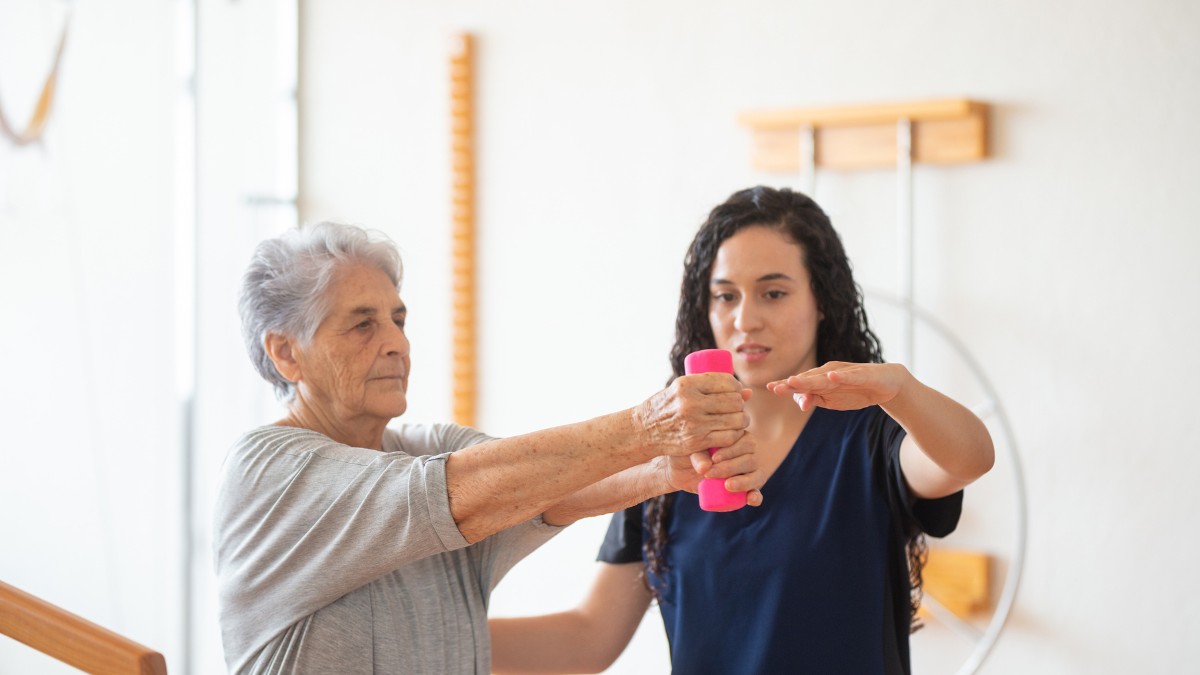Key Points:
- In-home occupational therapy supports individuals in regaining independence by improving their ability to perform everyday tasks in their own living environment.
- This type of therapy is beneficial for seniors, people recovering from injury or surgery, children with developmental delays, and individuals with chronic conditions.
- The comfort of receiving therapy at home enhances progress and makes treatment plans more personalized and practical.
If you or a loved one is struggling with daily tasks after an illness, surgery, or due to aging, you may be searching for support that doesn’t require a hospital stay or frequent clinic visits. That’s where in-home occupational therapy steps in. It’s a compassionate, effective way to bring skilled care directly into a person’s living environment, making therapy sessions more convenient, personalized, and relevant to real-life needs.
What Is In-Home Occupational Therapy?
In-home occupational therapy is a form of rehabilitation provided in a person’s home. It focuses on helping individuals regain the skills necessary to perform everyday tasks—also known as activities of daily living (ADLs). These tasks might include dressing, bathing, preparing meals, managing medications, or safely moving around the home.
Unlike therapy in a clinical setting, in-home occupational therapy is uniquely tailored to the person’s actual living conditions. That means therapy is not only more comfortable but also more relevant to real-world challenges a person might face at home.
Occupational therapists assess the home environment, suggest modifications, and guide patients through exercises and routines that build independence, confidence, and safety.
Who Can Benefit from In-Home Occupational Therapy?
In-home occupational therapy serves a wide range of individuals, but it’s particularly valuable for those who find it difficult to travel to outpatient clinics. Here’s a closer look at who can benefit.
Seniors Wanting to Age in Place
Older adults often experience reduced mobility, strength, and balance. An occupational therapist can help them stay safe at home by:
- Teaching strategies for fall prevention
- Recommending home modifications like grab bars or non-slip mats
- Assisting with fine motor skill recovery for grooming and meal prep
This support can be crucial in helping seniors stay independent longer and avoid hospital readmissions or nursing home placement.
Individuals Recovering from Surgery or Injury
After a surgery like a hip replacement or an injury like a stroke, getting back to routine tasks can be overwhelming. Occupational therapists help by:
- Developing a customized recovery plan
- Rebuilding strength and coordination through functional exercises
- Addressing pain management and energy conservation technique
Because therapy is done in the home, patients can practice real tasks like cooking in their own kitchen or getting in and out of their bed safely.
People with Chronic Illnesses or Disabilities
Conditions like Parkinson’s disease, arthritis, multiple sclerosis, or spinal cord injuries can significantly impact daily life. In-home therapy helps by:
- Providing adaptive tools and teaching their use
- Recommending environmental changes for accessibility
- Helping develop new ways to accomplish essential tasks with reduced physical strain
Children with Developmental Delays or Disabilities
For children, therapy in the familiar home setting can reduce anxiety and improve participation. Pediatric occupational therapy at home may help with:
- Fine motor skills like writing or self-feeding
- Sensory integration challenges
- Daily routines such as getting dressed or organizing toys
Therapists often involve caregivers to reinforce skills through play and routine activities.

What Does an In-Home Occupational Therapist Do?
When an occupational therapist visits your home, they begin by assessing both the patient and the living environment. Their goal is to identify challenges and provide practical solutions.
Personalized Assessment
The therapist will evaluate:
- The person’s range of motion, strength, and coordination
- Cognitive functions like memory and problem-solving
- The setup of the home and any hazards that could hinder daily living
This comprehensive evaluation allows them to design a therapy plan tailored to the patient’s goals and environment.
Skill-Building and Practice
Occupational therapists use therapeutic activities to help individuals:
- Relearn how to perform tasks like cooking, using the bathroom, or taking medications
- Improve hand-eye coordination, grip strength, and mobility
- Practice energy-saving techniques for fatigue management
Progress is continually measured and the program is adjusted accordingly.
Education and Support
A vital part of in-home occupational therapy is teaching both the patient and family members how to manage challenges. Therapists may:
- Train caregivers on safe transfer techniques
- Provide resources for adaptive equipment
- Offer emotional support and encouragement throughout the recovery process
Why Choose In-Home Occupational Therapy Over Clinic-Based Services?
There are several advantages to choosing in-home occupational therapy, especially for those with mobility limitations or complex needs:

For many families, in-home care feels more personal and empowering.
Common Home Modifications and Tools Recommended by Therapists
Occupational therapists often recommend changes or tools to make daily life easier and safer. Some examples include:
- Installing grab bars in the bathroom or shower
- Using reachers or long-handled tools for dressing
- Adding ramps or removing tripping hazards like loose rugs
- Reorganizing frequently used items for easier access
These small changes can make a big difference in independence and confidence.
When Should You Consider In-Home Occupational Therapy?
If you or a loved one:
- Struggles with basic self-care tasks
- Has difficulty moving safely around the home
- Is recovering from surgery, injury, or hospitalization
- Has a progressive condition affecting mobility or cognition
- Finds it hard to leave the home for outpatient care
Then it may be time to explore in-home occupational therapy. Early intervention often leads to better outcomes, helping people stay engaged in life and maintain their dignity.
Bringing Therapy Home Can Change Lives
In-home occupational therapy offers practical, personalized help where it matters most—at home. Whether it’s recovering from an accident, adjusting to a chronic condition, or helping a child meet developmental milestones, this service focuses on enabling people to live life on their own terms.
It’s not just about physical healing—it’s about restoring confidence, independence, and joy in the daily routines that make life meaningful.
Get the Support You Need with Revival Home Health Care
If you or a loved one is ready to regain control over daily life, Revival Home Health Care is here to help. Our licensed occupational therapists provide compassionate, customized care directly in your home—right where it’s needed most.
Whether you’re recovering from surgery, managing a chronic condition, or supporting a loved one’s well-being, our team is ready to guide you every step of the way. We proudly offer in-home occupational therapy in New York, helping individuals live safer, more independent lives.
Reach out today to schedule a consultation and take the first step toward greater independence and comfort at home.


 75 Vanderbilt Ave Staten Island, NY 10304
75 Vanderbilt Ave Staten Island, NY 10304 info@revivalhhc.org
info@revivalhhc.org 718.629.1000
718.629.1000